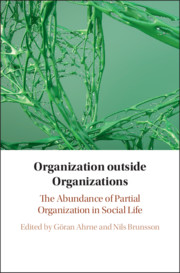Book contents
- Organization outside Organizations
- Organization outside Organizations
- Copyright page
- Contents
- Preface
- Contributors
- Introduction
- Part 1 Rules, Sanctions, Membership
- Part 2 Organization in and around Markets
- Part 3 Networks and Other Social Relationships
- Part 4 Social Movements and Collective Action
- Part 5 The Partial Organization of Formal Organizations
- Conclusion
- Index
- References
Part 1 - Rules, Sanctions, Membership
Published online by Cambridge University Press: 11 July 2019
- Organization outside Organizations
- Organization outside Organizations
- Copyright page
- Contents
- Preface
- Contributors
- Introduction
- Part 1 Rules, Sanctions, Membership
- Part 2 Organization in and around Markets
- Part 3 Networks and Other Social Relationships
- Part 4 Social Movements and Collective Action
- Part 5 The Partial Organization of Formal Organizations
- Conclusion
- Index
- References
Summary
In this chapter we discuss standards as forms of partial organization. Standards are defined as decided rules for common and voluntary use. Taking the example of CSR and corporate governance standards, we show that the degree of partiality of standards can vary widely – ranging from a single element of organization, i.e. decided rules, to all five elements of organization, i.e. decided rules, hierarchies, membership, monitoring and sanctioning. We demonstrate that in some cases partiality is the result of restrictions in the design of standards, while in other cases it is the result of an explicit choice. We also demonstrate that the degree of partiality of standards can change over time, as there are often pressures for standards to adopt additional organizational elements. Furthermore, we discuss the dispersed nature of many standards, showing how different actors often provide different organizational elements of standards without any central coordination. We close with an outline of an agenda for future research.
Keywords
- Type
- Chapter
- Information
- Organization outside OrganizationsThe Abundance of Partial Organization in Social Life, pp. 37 - 112Publisher: Cambridge University PressPrint publication year: 2019

